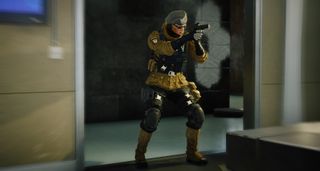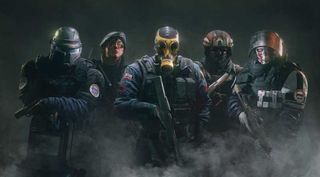5 things Rainbow Six Siege is doing better than other multiplayer shooters
Siege's destructibility, diverse gadgetry, mind games, and big map pool help make it an excellent tactical FPS.

Rainbow Six Siege is two years old, and it's aging well. Off the back of a 50-percent discount on all versions of the game in November, last weekend Siege hit 100,000 concurrent players, an all-time peak.
There's plenty of stuff that still needs to be improved in Siege: the frequency of teamkilling and leavers, 'spawn peeking,' 'dropshotting,' and that thing where one player loads into the first round of a match really slowly. But right now, here's why I think it's one of the best FPSes on PC.
It's not all about your aim
Marksmanship does matter in Siege—headshots are lethal, gun recoil varies, and you'll often see players aiming through tiny 'murder holes' in a wall to surprise opponents. But good gadgets, good information, or good timing can counter good aim.
Check the clip above: I'm in a 2v1 with 40 seconds left with my teammate Kootness, a PC Gamer Club member. We're out of stun grenades, and our opponent has a positional advantage—he's somewhere in the hostage room, but we don't know where. If we peek into the door, there's a good chance we'll instantly lose our heads because he only has to focus on a small bit of real estate.
Instead we try a timing attack, where my teammate and I enter the room simultaneously from the door and an opposite window. My breach alters the state of the map, the defender turns, and Kootness is set up to make the game-winning kill through the front door.

Multiple ways to contribute (even in death)
Virtually no other shooters value silence or stillness.
Siege isn't strictly about your K:D ratio, either. The way your team spends resources has a big influence on who wins, so much so that Siege reserves the opening minute of each round for laying defenses and gathering information. I love this phase because both teams get to feel each other out without the threat of death. It's a test of map knowledge. You can't reinforce every surface with steel walls: which ones are the most important? Should you place tripwire bombs in unexpected positions, or in more obvious, but higher-traffic doorways? A clever claymore mine can win a round.
And as an attacker, maneuvering your fragile surveillance drone onto the objective safely is a feat of miniature parkour and stealth. A carefully hidden drone can end up being the MVP.
The biggest gaming news, reviews and hardware deals
Keep up to date with the most important stories and the best deals, as picked by the PC Gamer team.
Those drones are also a gateway for dead players to participate in the round. When you die, you can live on as a guardian angel for your teammates, marking any enemies who walk into the field of view of cameras. Ubisoft said in a recent video that it believes there's lots of unexplored territory in this part of the game, and I'm hopeful they'll expand even more on the after-death tasks available to players.

Rainbow warriors
Rainbow Six is by-definition a diverse squad: a counter-terrorism team made up of operators from around the world. With Overwatch and Dirty Bomb, Siege is one of the few shooters where you can run an all-female team; 12 of the 36 operators are women. Brazil, Japan, Canada, France, Germany, and Hong Kong are all represented on the roster, with Italian and Moroccan operators coming in 2018. The most recent update, Operation White Noise, focused on the Korean 707th Special Mission Battalion, but also included Zofia, its second Polish character.
Psychological warfare
Siege's 18 maps are clusters of small rooms and hallways, layouts that often allow attackers to get extremely close to the objective before encountering an enemy. This phase—after setup, but before all-out combat—is a strange mixture of quiet and tension. You might be a few meters away from the enemy, but short sightlines and the abundance of walls usually grant enough safety to move, set up gadgets, and pause to communicate.
As Shaun wrote in 2016, this moment "is especially effective because there are virtually no other shooters that value silence or stillness." It's one of my favorite things about Siege, the space the game makes to poke at each other with gadgets, feints, and mind games. Some of my favorite fear-inducing maneuvers:
- Blowing up a segment of the ceiling, sending defenders scrambling
- Rolling a drone under a door, making eye contact with an enemy, and coyly rolling away
- Concussing someone over and over with Echo's hovering, invisible drone
- Marking an enemy over and over with a drone they can't find
- Making all enemies' phones audibly buzz with Dokkaebi's ability
- Barricading random doorways away from the objective to make attackers think about whether someone's inside
You can grind in PvE
Bots are uncommon in multiplayer FPSes. Siege's aren't very smart, but on certain variations of its PvE Terrorist Hunt mode, which has three difficulties, they can challenge experienced players with snappy aim or whole roomfuls of C4 traps. And each win earns some renown, Siege's non-cash currency.
More importantly, PvE is a low-pressure way for newcomers to learn some of Siege's sprawling maps. At the peak of CS:GO's popularity, a bunch of my friends who hadn't played wanted to jump in with me, but I couldn't offer them a true training mode like Terrorist Hunt to ease them into the mechanics.
I'm interested to see what Ubisoft does in the Outbreak "co-op event" it's teased for 2018. Outbreak is planned as a temporary addition, and apart from the expanding map roster it'll be basically the only addition to PvE since launch.

Evan's a hardcore FPS enthusiast who joined PC Gamer in 2008. After an era spent publishing reviews, news, and cover features, he now oversees editorial operations for PC Gamer worldwide, including setting policy, training, and editing stories written by the wider team. His most-played FPSes are CS:GO, Team Fortress 2, Team Fortress Classic, Rainbow Six Siege, and Arma 2. His first multiplayer FPS was Quake 2, played on serial LAN in his uncle's basement, the ideal conditions for instilling a lifelong fondness for fragging. Evan also leads production of the PC Gaming Show, the annual E3 showcase event dedicated to PC gaming.
Most Popular


